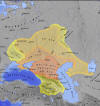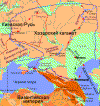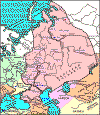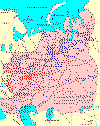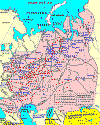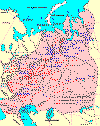Khazars and Khazaria probably have more dimensions than any other historical
phenomena. Their meteoric rise and collapse parallel that of the Vikings and England. A
small group of Vikings captured continental Brittany and became French-speaking Norman
rulers. A
small group of Normans captured insular Brittany and became its English-speaking rulers.
Soon, they dissolved, the land took over, and the Norman possession became the England we
know today. Likewise, a small Khazar tribe of the Bulgar and Suvar milieu was thrown to
the top by the interplay of the Avar, Bulgar, and Western Türkic Kaganates. Under their
name fell states and peoples incomparably more numerous and powerful, and for 400 years
they became personification of their subjects, much like the Normans in England, Spaniards in
Mexico, and Vikings in Rus. The Khazar's subjects became transparent. After the fall of the
Hunnic kingdom in the N. Caucasus, Khazars took over the defense of the Caucasus from the
Arab conquests, and grew to become a personification of the entire Eastern Europe for the
entire Moslem world. For a time, they became a great European power. And then, their
power was punctured by nearly sequential Arab assault, Kangar/Bosnyak conquest, Viking
assaults, split and expansion of the Rus principalities, Kipchak conquests, and revival of the Bulgar
independence. In 11th c., what in the 10th c. used to be called Khazaria became called
Kipchak. Kipchak fell under Mongolian rule, but the Khazar lands were never ruled from Mongolia,
they remained a part of the Kipchak lands till the disintegration of the Kipchak and its gradual
conquest by the Rus kingdom just before its own expiration.
In retrospect, the Khazar history somehow swaged down to the history of its
religious conversions, and the history of the Khazar people and subjects swaged down to the history of
the Ashkinazim. Without Ashkinazim, Khazars would become a background noise of the past.
The reigning powers of the area not only do not hold themselves as Khazar outcrops, they
actively create their own historical myths where Khazars do not exist. Forgotten is the
epos of the Khazar 150 years-long war with the Arab Caliphate, the Hunnic kingdom, the
Masguts called Alans, the Caucasian Kayis, the Tenriism that ruled most of the Eurasia,
the source of the European Islam, the source of the pre-Mongol Rus and Kipchak. They all
are invisible shades under a floodlight of religious conversions from one parochial
denomination to another. Gods of history work in mysterious ways.
At the same time, few nations can boast a richer history, more sparkling gems, higher
peaks and lower troughs than the Khazars. Just a list of the peoples, whose fate was
connected with the Khazar state, is both exceedingly long and incomplete. They are, of
course Khazars, and then the Huns, Avars, Bulgars, Kangars, Bechens, Kipchaks, Oguzes,
Slavs, Vikings, Masguts, Kayis, Armenians, Georgians, Adyges, Nakhs, Mordva, Merya,
Azeris, Arabs, Horezmians, Persians, Sogdians, Goktürks, Hungarians, and certainly
the Jews, Ashkenazim, Karaims, and the Tats. Even the possessed Hitler could not have
savored his slaughterhouse had not the Khazaria furnished him millions upon millions of the Khazar
Ashkenazim descendents, nor would Czechia and Poland develop their industries, nor would
England have its heyday under Disraeli, nor would France have its banker barons. Without
Khazars, the European history would go flat and moldy.






